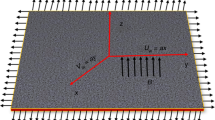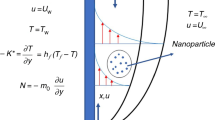Abstract
The application of magnetic nanofluid flow combines the versatility of nanotechnology with the manipulation capabilities of magnetic fields to address challenges and create innovative solutions across various industries. The proposed investigation explores the comprehensive analysis of magneto-micropolar hybrid nanofluid flow over an elongating surface, highlighting the critical roles of the shear rate as well as couple stresses. The nanofluid comprised of Ag and MoS4 nanoparticles in conventional fluid water characterizes their impact on the flow phenomena. The investigation employs “Response Surface Methodology” (RSM) coupled with “Analysis of Variance” (ANOVA) to optimize the influential parameters likely the particle concentrations and the magnetic parameter governing the flow behavior and heat transfer characteristics. A broad mathematical formulation is established considering the effect of thermal buoyancy, dissipative heat, and thermal radiation. The governing partial differential equations are solved numerically with the help of shooting-based Runge–Kutta technique followed by similarity rules which are used to transform these equations into ordinary. Through RSM and ANOVA, the significant factors affecting the flow and heat transfer characteristics are identified, enabling the determination of optimal operating conditions for enhanced performance. The outcomes of the study show optimization of systems involving micropolar hybrid nanofluids, with potential applications in various engineering and industrial processes. Additionally, the integration of RSM and ANOVA shows an effective approach for elucidating the optimized shear as well as couple stress for the involvement of several factors.

















Similar content being viewed by others
Data availability
No data are used.
Code availability
Not applicable.
References
Sahoo B, Dash SK, Gogoi BP. Thermal transport properties of micropolar nanofluid in a heated channel: a numerical investigation. J Therm Anal Calorim. 2023;151:1197–211.
Rana B, Singh PK, Alim M. Heat transfer enhancement in a micropolar nanofluid-filled annulus with different nanoparticle shapes. J Mol Liq. 2023;349: 119177.
Boukrouche M, Sahai A, Ghanem R. Mixed convection in a lid-driven cavity filled with a micropolar nanofluid: effect of nanoparticle shape. J Therm Sci Eng Appl. 2022;14: 041010.
Kumar A, Singh M, Jain S. Heat transfer and pressure drop characteristics of micropolar nanofluid in a circular tube with twisted tape inserts. J Heat Transf. 2023;145: 071702.
Khan MS, Ellahi A, Khan M. Entropy generation in a micropolar nanofluid flow over a stretching cylinder with non-uniform heat source/sink. Int J Heat Mass Transf. 2022;184: 121835.
Shehzad SA, Nadeem S, Ellahi R. Magnetohydrodynamic mixed convective flow of micropolar nanofluid with Cattaneo-Christov heat flux model. Phys Fluids. 2023;35: 012003.
Sharma N, Sharma K, Kumar M. Investigation of micropolar nanofluid flow over a stretching sheet with nonlinear thermal radiation and chemical reaction. J Therm Sci Eng Appl. 2022;14: 061009.
Zeeshan A, Alim M, Khan M. Mixed convection flow of a micropolar nanofluid over a stretching cylinder with chemical reaction. J Nanofluids. 2023;12:1401–14.
Sivasankaran M, Mahdy A, Hayat T. Mixed convection flow of micropolar nanofluid over a stretching sheet with nonlinear thermal radiation. Int J Numer Methods Heat Fluid Flow. 2022;33:7700–21.
Das S, Biswas N, Nandy S. Micropolar nanofluid flow past a stretching cylinder with viscous dissipation and Joule heating effects. Heat Transf Asian Res. 2023;52:137–59.
Sharma A, Gupta S, Kumari, S. Investigation of thermal and transport properties of Cu-water-based micropolar nanofluids. J Mol Liq, 2022;351.
Hussain S, et al. A comprehensive review on the applications of micropolar nanofluids in heat transfer and thermal engineering. Renew Sustain Energy Rev. 2022;157.
Javed M, Iqbal S, Ellahi R. Hydromagnetic mixed convection flow of micropolar nanofluid over a stretching sheet with thermophoresis and Brownian motion effects. Int J Heat Mass Transf. 2022;186
Bhattacharyya S, et al. Convective heat transfer analysis of micropolar nanofluids in a concentric annulus with sinusoidal wavy walls. Int J Therm Sci. 2022;181
Rahman, A. A. et al. MHD boundary layer flow and heat transfer of micropolar nanofluid over a stretching sheet with suction/injection. Int J Numer Methods Heat Fluid Flow. 2022;32
Kaur H, Mahajan A. Influence of inclined magnetic field on MHD micropolar nanofluid flow and heat transfer. J Magn Magn Mater. 2022;553.
Ellahi R et al. MHD convective peristaltic flow of a micropolar nanofluid with slip effects and Joule heating. Int J Numer Methods Heat Fluid Flow. 2022;32.
Hayat T. et al. Magnetohydrodynamic flow and heat transfer of a micropolar nanofluid with thermal radiation and convective condition. Phys Lett A. 2022;397
Kumar S, et al. Heat transfer and fluid flow of micropolar nanofluids with Cattaneo-Christov double diffusion and chemical reaction. Int J Heat Mass Transf. 2022;180
Kundu SK, Hossain MA. Effects of magnetic field and slip boundary on the micropolar nanofluid flow and heat transfer over a stretching sheet. J Mol Liq. 2023;383
Tripathy RS, et al. Numerical analysis of hydromagnetic micropolar fluid along a stretching sheet embedded in porous medium with non-uniform heat source and chemical reaction. Eng Sci Technol Int J. 2016;19:1573–81.
Salawu SO, et al. Elastic deformation of thermal radiative and convective hybrid SWCNT-Ag and MWCNT-MoS4 magneto-nanofluid flows in a cylinder. Results Mater. 2023;17:100380.
Rashidi MM, et al. Comprehensive review on exergy analysis of shell and tube heat exchangers. J Therm Anal Calorim. 2022;147(22):12301–11.
Shahid A, et al. Numerical analysis of activation energy on MHD nanofluid flow with exponential temperature-dependent viscosity past a porous plate. J Therm Anal Calorim. 2021;143:2585–96.
Shamshuddin MD, et al. Bioconvective treatment for the reactive Casson hybrid nanofluid flow past an exponentially stretching sheet with ohmic heating and mixed convection. J Therm Anal Calorim. 2023. https://doi.org/10.1007/s10973-023-12465-x.
Shamshuddin MD, et al. Case study of thermal and solutal aspects on non-Newtonian Prandtl hybrid nanofluid flowing via stretchable sheet: multi slip solution. Case stud Therm Eng. 2023;49:103186.
Shamshuddin MD et al. Dynamics of ethylene glycol conveying SWCNTs: significant joule heating and thermal radiation. Numer Heat Transf A. 2023. https://doi.org/10.1080/10407782.2023.2195130
Shamshuddin MD, Sharma RP. Thermal elaboration of ethylene glycol-based magnetized nanostructures via a convective permeable heated vertical surface employing modified Buongiorno model. J Magn Magn. 2023;571:170588.
Funding
Not applicable.
Author information
Authors and Affiliations
Contributions
All the authors have equally contributed to complete the manuscript, i.e., RB has formulated the problem, SRM has completed the introduction section and checked the similarity with grammar, PKP has computed and simulated the numerical results, and finally, SP has completed the draft with results and discussion section and checked the overall.
Corresponding author
Ethics declarations
Conflict of interest
There is no conflict of interest to publish our paper in your esteemed journal.
Ethical approval
The entire work is the original work of the authors.
Consent to participate
Not applicable.
Consent for publication
All the authors have given their consent to publish the paper.
Additional information
Publisher's Note
Springer Nature remains neutral with regard to jurisdictional claims in published maps and institutional affiliations.
Rights and permissions
Springer Nature or its licensor (e.g. a society or other partner) holds exclusive rights to this article under a publishing agreement with the author(s) or other rightsholder(s); author self-archiving of the accepted manuscript version of this article is solely governed by the terms of such publishing agreement and applicable law.
About this article
Cite this article
Baithalu, R., Mishra, S.R., Pattnaik, P.K. et al. Optimizing shear and couple stress analysis for the magneto-micropolar dissipative nanofluid flow toward an elongating surface: a comprehensive RSM-ANOVA investigation. J Therm Anal Calorim 149, 1697–1713 (2024). https://doi.org/10.1007/s10973-023-12741-w
Received:
Accepted:
Published:
Issue Date:
DOI: https://doi.org/10.1007/s10973-023-12741-w




